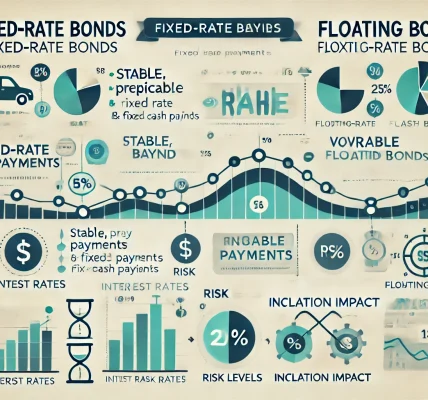Introduction
When it comes to building a robust investment portfolio, diversification is key. It helps to spread out risk and maximize returns over time, ensuring that your portfolio isn’t too exposed to any single investment type or market movement. One of the most reliable and stable options for diversification is bonds. While stocks often steal the spotlight in the world of investing, bonds play a crucial role in balancing risk and offering stability to a portfolio. In this blog, we’ll explore how bonds help diversify your investment portfolio and why they should be considered by every investor.
What Are Bonds?
A bond is essentially a loan that investors provide to entities like governments, municipalities, or corporations. In exchange for the loan, the issuer of the bond agrees to make regular interest payments (known as coupon payments) to the bondholder and to repay the principal at maturity. Bonds are typically considered a safer investment than stocks, especially government and investment-grade corporate bonds.
How Bonds Contribute to Portfolio Diversification
Diversification is the strategy of holding a mix of different types of investments to reduce risk. The primary objective is to ensure that the performance of one asset class (such as stocks) doesn’t unduly affect the entire portfolio. Bonds can play an integral role in achieving this by providing stability, predictable income, and reduced volatility. Here’s how:
- Lower Volatility Compared to Stocks
- Stocks can experience significant fluctuations due to market conditions, company performance, and investor sentiment. In contrast, bonds tend to have lower volatility. While bond prices can fluctuate due to changes in interest rates and economic conditions, they generally don’t experience the sharp swings seen in the stock market. This makes bonds an excellent option for stabilizing a portfolio, especially during periods of stock market turmoil.
- Predictable Income Stream
- Bonds offer regular coupon payments, providing a predictable income stream for investors. This is particularly important for retirees or conservative investors who want to ensure a steady flow of income without the risk of losing principal. In times when stock dividends may be reduced or unavailable, bonds provide a more reliable source of income.
- Counter-Cyclicality to Stock Market
- One of the most significant advantages of adding bonds to your portfolio is their behavior during market downturns. Historically, when stock markets decline, bond prices tend to either remain stable or increase. This makes bonds an excellent hedge against stock market risk, providing safety and stability during times of economic uncertainty. Bonds can perform well when stocks are underperforming, providing a balancing effect that reduces overall portfolio risk.
- Inflation Protection with Certain Bonds
- While inflation erodes the value of cash and certain assets, certain types of bonds, like Treasury Inflation-Protected Securities (TIPS), are specifically designed to combat inflation. TIPS are government-issued bonds that adjust their principal value based on inflation, ensuring that the bondholder’s investment keeps pace with rising prices. This makes them a strong choice for investors looking to protect their portfolios from inflationary pressures.
- Diversification of Risk Exposure
- Bonds allow investors to diversify across different sectors, credit qualities, and maturities. For example, you can diversify by investing in government bonds (such as U.S. Treasuries), municipal bonds, corporate bonds, or international bonds. This variety helps spread risk across different types of issuers and sectors, reducing the impact of negative events in any one area. Investing in bonds from different countries can also help protect your portfolio against risks associated with specific regions or economies.
Types of Bonds for Diversification
- Government Bonds
- These are issued by national governments and are considered one of the safest types of bonds. They provide low risk but lower yields as well. U.S. Treasury bonds, for instance, are highly rated and offer security for long-term investors.
- Municipal Bonds
- Issued by local governments, municipal bonds can offer tax advantages, making them a popular choice for high-net-worth individuals. These bonds tend to be a bit riskier than government bonds but still provide a stable source of income.
- Corporate Bonds
- These bonds are issued by companies and offer higher yields than government bonds. However, they come with a higher degree of risk because the issuer may face financial difficulties. Investment-grade corporate bonds offer a good balance of risk and return, while high-yield bonds (also known as junk bonds) provide higher returns but come with greater risk.
- International Bonds
- Investing in bonds issued by foreign governments or corporations allows investors to diversify their portfolios geographically. International bonds can provide access to emerging markets, which may offer higher yields compared to domestic bonds, but they also come with currency risk and political risk.
- Bond Funds and ETFs
- If you want exposure to a diversified group of bonds without purchasing individual bonds, bond funds or exchange-traded funds (ETFs) can be a great option. These funds pool money from many investors to buy a portfolio of bonds, providing instant diversification across various issuers and bond types.
How to Incorporate Bonds into Your Portfolio
The ideal bond allocation in your portfolio depends on your risk tolerance, investment goals, and time horizon. Here are a few guidelines to consider:
- Risk Tolerance
- If you are risk-averse and looking for stability, you may want to allocate a larger portion of your portfolio to bonds. Government and high-quality corporate bonds are more secure but offer lower yields.
- Investment Horizon
- For long-term investors with a higher risk tolerance, a smaller allocation to bonds might be appropriate. Stocks tend to offer higher returns over the long term, but bonds can still provide diversification and reduce overall volatility.
- Bond Laddering
- Another strategy is bond laddering, where you invest in bonds with staggered maturities. This helps ensure you have bonds maturing at different intervals, providing liquidity and reducing the impact of interest rate changes.
- Rebalancing Your Portfolio
- It’s important to periodically review and rebalance your portfolio to ensure that your bond allocation remains aligned with your goals. If stock markets have performed well and bond prices have risen, you may need to adjust your allocations.
Conclusion
Bonds are an essential component of a well-diversified investment portfolio. They offer stability, a predictable income stream, and the ability to hedge against stock market risk. By understanding the different types of bonds and how they behave in various market conditions, you can use them effectively to reduce overall portfolio risk and maximize returns. Whether you’re an experienced investor or just starting, bonds should be an integral part of your investment strategy.


